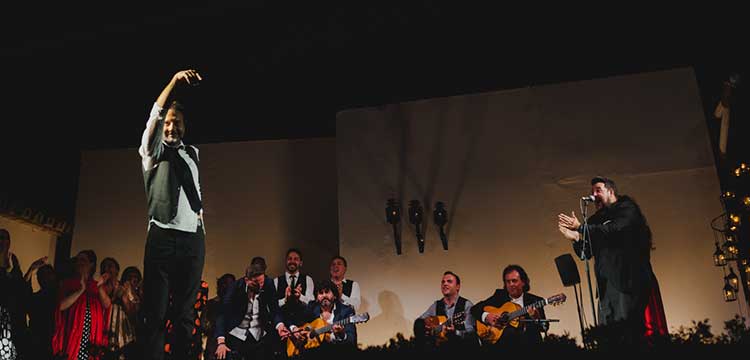LI Reunión de Cante Jondo
Saturday, July 13, 2019. 11:00pm
La Puebla de Cazalla, Hacienda La Fuenlonguilla
Text: Estela Zatania
Photos & video: Tamara Pastora
With the hangover of a half-century of the Reunión de Cante Jondo de La Puebla de Cazalla that was celebrated last year and which is still a happy memory, last night’s posters debuted the minimalist Roman numeral LI indicating that this was the 51st edition.
Flamenco was implanted here decades ago by painter and poet Francisco Moreno Galván, who would have been very happy to see how enthusiastically and seriously his people have learned their flamenco lesson. Miguel Vargas, Diego Clavel, La Niña de La Puebla, the maestro José Menese and we should also include Luis Torres “Joselero”, give a picture of the admirable historic line-up of singers from La Puebla.
This is an event that takes a stand, no matter how you look at it. The cultural activities with exhibits, recitals and lectures, the serious respectful format, the desire to listen and to learn, everything in La Puebla is done with pride. And the attention to this year’s program, with the passing of Menese three years ago, took on the challenge of helping and encouraging the youngest interpreters.
Antonio Flores “Rubio de Pruna”, the last singer of Paco de Lucía, as emcee Faustino Núñez pointed out, was accompanied on guitar by Pepe del Morao, young representative of the famous Morao family of Jerez. Rubio de Pruna has an unusual voice, velvety but powerful, which served well for bulería por soleá with a straightforward delivery. The self-assurance that comes from years of singing for dance, with the command of a soloist. “Y Dios te va a mandar un castigo muy grande”, what a strong ending! For siguiriyas, Pepe del Morao couldn’t have sounded more of Jerez, and the singer went with the flow: ”No llamarme al médico, llamarme al doctor”, “Mi hermana Alejandra”…how wonderful the classic verses sound.
In tientos, he elegantly recalled Gaspar, in addition to singing the verse that most identifies Menese, “señor que va a caballo”. For tangos, he became Camarón, and once again I defend the autonomy of tientos which always becomes devalued when employed as a prologue for tangos. The singer ended with classic bulerías of Gaspar, La Repompa, La Perla and others, and not even a malfunctioning microphone could deprive him of the autience’s enthusiastic standing ovation.
Manuel de la Tomasa, twenty years old, with the sincerity of his youth, and legendary ancestors to back him up. Antonio Carrión, always present at this festival, accompanied him for soleá with the compás of Marcos Carpio and El Pirulo, and some sublime moments were reached. Alegrias cantinas triggered an effusive reaction, and with siguiriyas “of my family”, Manuel completely won over the audience.
Ana Ramírez “La Yiya” is a portrait of restraint, delicacy and knowledge. With the guitar of Antonio Garcia, and the rhythm of Sofía and Noelia Jiménez de la Rosa, she interpreted romance, petenera, some tangos in the fast lane with retro flavor and siguiriyas.
With Antonio Cáceres on guitar, and the rhythm of Joaquín González, Manuel Vinaza and Luis Dorado, Rubito Hijo, La Puebla native and holder of the Lámpara Minera, sang an assortment of traditional tientos tangos, and bulerías with classic songs such as Manolito de María’s “Padre Nuestro” as well as “Compromiso” and “Se Llamaba Carmen” among others. Jerez forms of siguiriyas rounded out a sincere and committed performance: it was a pity the audience began filing out due to the cold wind that had begun to invade the large patio.
Catalonian singer Montse Cortés was the senior member of this year’s line-up. Attractive with her long blond hair, and her silky, sweetly sad voice, sang malagueñas of Peñaranda and Mellizo, ending with abandolao. The last time Montse sang at the Reunión de Cante Jonde, she didn’t quite click with the audience, but on this occasion she knew how to win them over. A nostalgic version of Camarón and Paco’s “Canastera” went over well with those of a certain age. Tangos de la Repompla, fragile and vulnerable and some contemporary bulerías to end. Montse was backed up by the guitar of José Fernández “Petete”.
The program was overly long for some people, partly due to the inclusion of two dance groups, those of Luisa Palicio and Fuensanta la Moneta respectively. Palicio moves with the expansive gestures of a diva, but the voices of Ana Gómez and the pharaonic Juan José Amador, with the guitar of Jesús Rodríguez and the percussion of David “Chupete” kept things anchored in flamenco. Luisa interpreted a guajira with retro feeling, and soleá, both with bata de cola and the elegant style of her mentor, Milagros Mengíbar.
If Luisa Palicio is light, Fuensanta la Moneta is darkness and shadow. In the most positive sense. Granada temperament, bursts of energy, a look that takes no prisoners and powerful silences. No matter how much others may sterilize and domesticate flamenco dance, we’ll always have Fuensanta to put things back in place. Ismael de la Rosa “El Bola” and Mercedes Cortés took care of the vocals with the guitar of Víctor “Tomate”.
We can’t overlook the fine guitar solos of Antonio Cáceres, the traditional round of tonás and the bulerías fiesta finale. A long night, but what would we do without the Reunión de Cante Jondo de La Puebla de Cazalla?
